Animation Artifacts &Story & Storyboards 07 Nov 2006 08:44 am
Jax Beer Spot
- Here’s the material for a Jax Beer commercial. It was done by a NY studio named Pelican in 1962. There were about 75 people on staff at Pelican back then.
This spot was directed by Mordi (Mordicai) Gerstein. He left animation to write & illustrate children’s books in th 70′s. (He won the Caldecott Medal for his book, The Man Who Walked Between The Towers. This was the book I adapted to animation last year.)
What follows is the storyboard and the director’s workbook. (It appears to be an agency board, though it’s drawn in a style that looks to be Mordi Gerstein’s. Perhaps boards from the agency were drawn by the studios back in 1964; I’m not sure. The layouts were drawn by the same artist.)
Tomorrow I’ll post some of those layouts.
The workbook has several flaps on it that indicate changes in timings. There are also glue stains where I assume other flaps fell off. (See page one, last row, first column.) Each column represents 16 frames/one foot of film. Odd numbers are marked off.
Each row contains 8 feet of film/128 frames. Each page represents 32 feet/512 frames. It would have been smarter to keep to even numbers.
More modern exposure sheets generally have 80 frames/five feet per page. This also divides into two feet of 16mm film. (Handy.) The numbers add and divide smartly and easily. But then most people don’t use exposure sheets anymore.
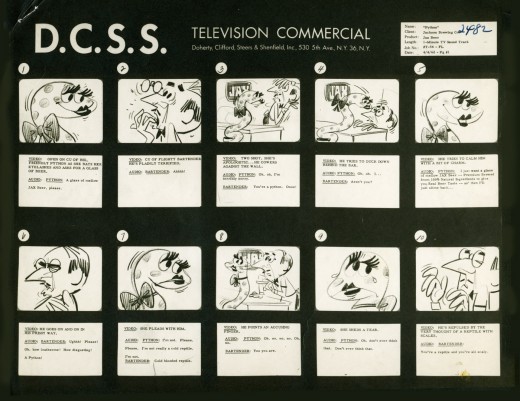
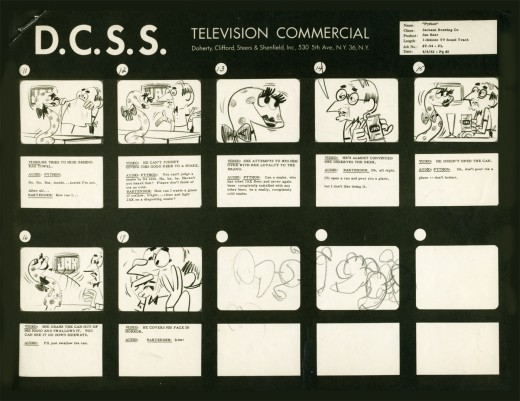
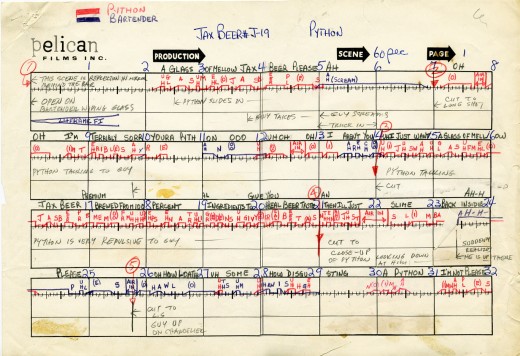
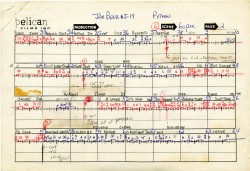
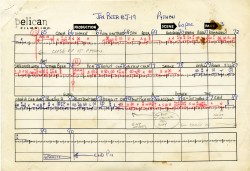

on 07 Nov 2006 at 1:17 pm 1.Hans Perk said …
“But then most people don’t use exposure sheets anymore.”
on 07 Nov 2006 at 1:18 pm 2.Hans Perk said …
(The above had a ‘SIGH!’ appended…)
on 07 Nov 2006 at 3:54 pm 3.JK said …
Thank you for your continued sharing of these materials. I not sure why there is a reference to exposure sheets in this posting, as the presented documents are of course bar sheets and very different in usage and appearance from exposure sheets. Many studios and independents still use all of these documents with some modifications. It all depends on how they approach the planning process.
on 07 Nov 2006 at 4:48 pm 4.Michael said …
My point was that the bar sheets had an odd numbering breakdown, wheras recent exposure sheets were broken into a more useful formula.
on 08 Nov 2006 at 1:19 am 5.Kevin Langley said …
Wow, thanks for sharing those bar sheets. I always love looking at that stuff.
on 08 Nov 2006 at 3:11 am 6.Hans Perk said …
The bar sheets and exposure sheets we used to use were in the same scale, so you could put the exposure sheet over the bar sheet and directly copy the information. I guess this was pretty much industry standard for those who knew. They were normally 6 foot sheets, and were basically copies of copies that originally originated at Disney’s, where they had a lot of different size sheets, of course. The ones I have seen most often were 5 and 6 foot sheets, devided every 8 frames. The 5 foot sheets were “first page” sheets. I have seen a lot of 100 frame sheets (4 seconds of TV in Europe), and other interesting and odd sizes…
on 09 Jan 2009 at 2:16 pm 7.Don Carlson said …
Hello,
I am a stop motion animator and I am confused why you would want to number the X-sheets with odd numbers on twos instead of evens?
Also, if you shoot video, do you round up or down to the nearest frame when you’re subdividing a second? *I.E, is a quarter of a second 7 frames or 8? 7.5 frames isn’t possible, so it has to be one or the other.
Best,
Don
on 09 Jan 2009 at 3:01 pm 8.Michael said …
Hi Don, I work at 24 fps in all situations and a quarter of a second is 6 frames. I allow the computer to then interpret it to a 29.97 alteration.
The first frame, to me, is not “0″ it’s “1″. Consequently, you start with #1, then continue so that every frame can be identified. (This is the Disney system; it’s not a system I personally use.)
on 06 Apr 2009 at 12:14 pm 9.Don Carlson said …
Thanks, Michael!
I just now saw this post. I agree that it’s best to let the computer do the conversion. My timing improved by leaps and bounds when I started timing at 24 fps.
on 13 Sep 2009 at 6:33 pm 10.Don Carlson said …
By the way, just out of curiosity what numbering system do you use?
on 14 Sep 2009 at 11:54 am 11.Michael said …
Bot level A’s, B’s up from that etc. This way I always know what level a drawing is on.
I number the drawings 1-whatever without regard to the frame number. Dial numbers do that job.